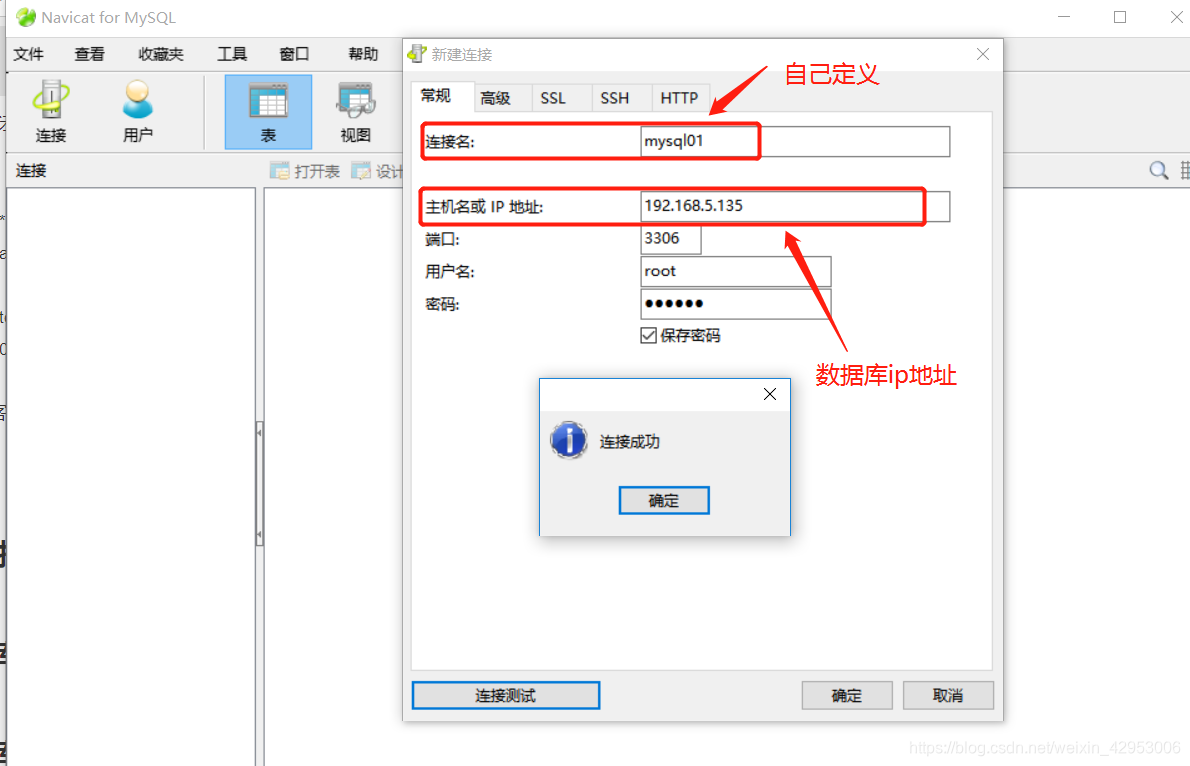文章目录
一、MySQL数据库的访问
1.1、概述
MySQL数据库是一个典型的C/S架构的应用,要访问MySQL数据库需要使用专门的客户端软件。
1.2、Linux系统访问mysql
在Linux系统中用自带的mysql命令工具即可访问mysql数据库
[root@localhost ~]# mysql -u root -p
Enter password: ##输入密码
mysql> ##登陆成功
mysql> show databases; ##查看数据库列表
+--------------------+
| Database |
+--------------------+
| information_schema |
| mysql |
| performance_schema |
| sys |
+--------------------+
4 rows in set (0.09 sec)
mysql>
1.3、win10系统图形化界面访问mysql
- 设置mysql数据库权限,关闭防火墙
mysql> grant all privileges on *.* to 'root'@'%' identified by 'abc123' with grant option;
Query OK, 0 rows affected, 1 warning (0.11 sec)
##允许数据库中的所有表,所有权限给root用户
[root@localhost ~]# systemctl stop firewalld.service ##关闭防火墙
[root@localhost ~]# setenforce 0 ##关闭增强型安全功能
- 在W10系统中安装Navicat客户端软件,设置连接配置

- 连接完成后即可操作mysql数据库

二、MySQL数据库的常用命令
2.1、查看数据库列表
- show databases;
mysql> show databases;
+--------------------+
| Database |
+--------------------+
| information_schema |
| mysql |
| performance_schema |
| sys |
+--------------------+
4 rows in set (0.00 sec)
mysql>
2.2、查看数据库中的数据表列表
- 数据表存放在数据库中,先进入所要查看的数据表的数据库才能查看数据表信息。
- USE 数据库名;
- SHOW TABLES;
mysql> use sys; ##进入sys库
Reading table information for completion of table and column names
You can turn off this feature to get a quicker startup with -A
Database changed
mysql> show tables; ##查看sys库的数据表列表
+-----------------------------------------------+
| Tables_in_sys |
+-----------------------------------------------+
| host_summary |
| host_summary_by_file_io |
| host_summary_by_file_io_type |
//更多信息.....
2.3、显示数据表结构(字段)
- DESCRIBE [数据库名.]表名;
mysql> describe host_summary; ###显示host_summary数据表的结构
+------------------------+---------------+------+-----+---------+-------+
| Field | Type | Null | Key | Default | Extra |
+------------------------+---------------+------+-----+---------+-------+
| host | varchar(60) | YES | | NULL | |
| statements | decimal(64,0) | YES | | NULL | |
| statement_latency | text | YES | | NULL | |
| statement_avg_latency | text | YES | | NULL | |
| table_scans | decimal(65,0) | YES | | NULL | |
| file_ios | decimal(64,0) | YES | | NULL | |
| file_io_latency | text | YES | | NULL | |
| current_connections | decimal(41,0) | YES | | NULL | |
| total_connections | decimal(41,0) | YES | | NULL | |
| unique_users | bigint(21) | NO | | 0 | |
| current_memory | text | YES | | NULL | |
| total_memory_allocated | text | YES | | NULL | |
+------------------------+---------------+------+-----+---------+-------+
12 rows in set (0.00 sec)
mysql>
三、SQL语句
3.1、SQL语句概述
- 是结构化查询语言
- 是关系型数据库标准语言
- 用于维护管理数据库,如数据库查询、数据更新、访问控制、对象管理等功能
3.2、SQL语句分类
- DDL:数据定义语言
- DML:数据操控语言
- DQL:数据查询语言
- DCL:数据控制语言
四、SQL语句之DDL语句操作
4.1、DDL语句概述
DDL语句用于创建和删除数据库对象,如库、表、索引等
4.2、创建数据库
- 格式: CREATE DATABASE 数据库名
例如:
mysql> create database abc; ##创建abc库
Query OK, 1 row affected (0.01 sec)
mysql> show databases; ##查看库列表
+--------------------+
| Database |
+--------------------+
| information_schema |
| abc | ##abc库已创建
| mysql |
| performance_schema |
| sys |
+--------------------+
5 rows in set (0.00 sec)
mysql>
4.3、创建数据表
- 格式:CREATE TABLE 表名(字段定义…)
例如:
mysql> use abc; ##进入abc库
Database changed
mysql> create table abc01( ##创建abc01表
-> id int not null, ##定义表中字段
-> name char(10) not null,
-> address varchar(50) default 'BJ',
-> primary key (id));
Query OK, 0 rows affected (0.43 sec)
mysql> describe abc01; ###查看数据表结构
+---------+-------------+------+-----+---------+-------+
| Field | Type | Null | Key | Default | Extra |
+---------+-------------+------+-----+---------+-------+
| id | int(11) | NO | PRI | NULL | |
| name | char(10) | NO | | NULL | |
| address | varchar(50) | YES | | BJ | |
+---------+-------------+------+-----+---------+-------+
3 rows in set (0.01 sec)
mysql>
4.4、删除指定的数据表
- 格式:DROP TABLE [数据库名.]表名
例如:
mysql> drop table abc.abc01; ##删除abc01数据表
Query OK, 0 rows affected (0.04 sec)
mysql> use abc; ##进入abc库
Database changed
mysql> show tables; ##查看数据表列表
Empty set (0.00 sec)
####没有任何数据表,abc01数据表已被删除
mysql>
4.5、删除指定的数据库
- 格式:DROP DATABASE 数据库名
例如:
mysql> drop database abc; ##删除abc数据库
Query OK, 0 rows affected (0.01 sec) ##ok,删除成功
五、SQL语句之DML语句操作
5.1、DML语句概述
- DML语句用于对表中的数据进行管理,包括以下操作
5.2、插入新数据(INSERT)
- 格式:INSERT INTO 表名(字段1,字段2,…)VALUES(字段1的值,字段2的值,…)
例如:
- 创建一个abcd01的数据表,往其中插入相关数据
mysql> create database abcd; ##创建abcd库
Query OK, 1 row affected (0.00 sec)
mysql> use abcd; ##进入abcd库
Database changed
mysql> create table abcd01( ##创建abcd01表
-> id int(4) not null,
-> name char(10) not null,
-> address varchar(50) default 'NJ',
-> primary key (id));
Query OK, 0 rows affected (0.04 sec)
mysql> desc abcd01; ##显示abcd01表的结构
+---------+-------------+------+-----+---------+-------+
| Field | Type | Null | Key | Default | Extra |
+---------+-------------+------+-----+---------+-------+
| id | int(4) | NO | PRI | NULL | |
| name | char(10) | NO | | NULL | |
| address | varchar(50) | YES | | NJ | |
+---------+-------------+------+-----+---------+-------+
3 rows in set (0.01 sec)
mysql> insert into abcd01(id,name)values(1,'zhangsan');
##插入数据id=1,姓名zhangsan
mysql> select * from abcd01; ##查看表中数据内容
+----+----------+---------+
| id | name | address | ##id已经为1,姓名为zhangsan
+----+----------+---------+
| 1 | zhangsan | NJ |
+----+----------+---------+
1 row in set (0.00 sec)
mysql>
5.3、更新原有数据(UPDATE)
- 格式:UPDATE 表名 SET 字段名1=值1 WHERE条件表达式
例如:
mysql> update abcd01 set name='wangwu' where id =1;
##修改id为1的字段姓名为wangwu
mysql> select * from abcd01; ##显示表中数据内容
+----+--------+---------+
| id | name | address |
+----+--------+---------+ ##姓名已变为wangwu
| 1 | wangwu | NJ |
+----+--------+---------+
1 row in set (0.00 sec)
5.4、删除不需要的数据(DELETE)
- 格式:DELETE FROM 表名 WHERE 条件表达式
例如:
mysql> delete from abcd01 where id =1; ##删除id为1的字段的数据
Query OK, 1 row affected (0.01 sec)
mysql> select * from abcd01; ##显示表中数据内容
Empty set (0.00 sec) ##变为空
六、SQL语句之DQL语句操作
6.1、概述
- DQL是数据查询语句,只有一条SELECT命令
- 用于从数据表中查找符合条件的数据记录
- 查询时可不指定条件
6.2、数据表内容查询(SELECT)
- 格式:selext 字段名1,字段名2… from 表名;
例如:上面查询abcd01数据表的信息("*"代表所有数据)

七、SQL语句之DCL语句操作
7.1、设置用户权限(GRANT)
- 格式 :GRANT 权限列表 ON 数据库名.表名 TO 用户名@来源地址 [ IDENTIFIED BY ‘密码’ ]
例如:
mysql> grant all privileges on *.* to 'root'@'%' identified by 'abc123' with grant option;
Query OK, 0 rows affected, 1 warning (0.11 sec)
##允许数据库中的所有表,所有权限给root用户
7.2、查看用户的权限
- SHOW GRANTS FOR 用户名@来源地址
7.3、撤销用户的权限(REVOKE)
- REVOKE 权限列表 ON 数据库名.表名 FROM 用户名@来源地址
